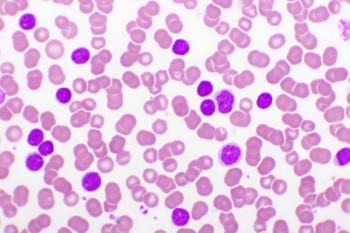
Several Treatment Classes Show Promise in Treatment of PV
The review comes amid growing attention directed at identifying treatments that can prevent progression of polycythemia vera (PV) to myelofibrosis or an aggressive form of acute myeloid leukemia.
A pair of researchers
The review comes amid growing attention directed at identifying treatments that can prevent progression of PV to myelofibrosis or an aggressive form of acute myeloid leukemia.
“Ultimately, the goals of therapy in this chronic disease are to improve quality of life, reduce risk of thrombosis, and alter disease course,” wrote the pair. “The therapeutic landscape of PV is evolving because of a more thorough understanding of the molecular mechanisms driving the pathogenesis and progression of this disease.”
For example, some focus has been paid to combining pegylated interferon (IFN) with agents like ruxolitinib. A phase 2 study looking at the treatment combination in 32 patients with PV and myelofibrosis showed a 31% remission rate and 9% complete remission rate. Notably, the study also showed that a significant number of patients cannot tolerate IFN-alfa-2a, with nearly one-third of patients in the study dropping out, likely due to the side effects of the treatment.
Another phase 2 randomized study is currently assessing the effects of ropeginterferon-alfa-2b compared with phlebotomy alone in patients with low-risk PV. Interim results indicated that 84% of patients receiving the IFN-alfa-2a treatment met the primary endpoint of percentage of patients maintaining a hematocrit of not more than 45% over 1 year without evidence of disease progression (P = .008). In comparison, 60% of patients receiving phlebotomy alone met the endpoint.
MDM2 inhibitors have also been suggested as an attractive treatment class. A phase 1 study of patients with refractory PV receiving oral MDM2 antagonist idasanutlin showed a 58% response rate and a 50% response rate when the treatment was combined with IFN-alfa-2a treatment.
Results from a phase 2 study of the nutlin KRT-232 are anticipated. The study includes phlebotomy-dependent patients with PV.
With iron deficiency being a prevalent issue among patients with PV, the addition of hepcidin agonists is being explored to restrict systemic iron metabolism. PTG-300 is currently being studied in a phase 2 trial of 13 patients with PV, with preliminary findings indicating that the treatment is both safe and tolerable. All patients have maintained hematocrit of less than 45% without phlebotomy for up to 7 months, and iron deficiency appears to be reversing based on increasing ferritin, iron, and transferrin saturation levels.
A fourth class of treatment, histone deacetylase inhibitors, is also being explored. Givinostat was tested in a phase 1b/2 study of patients with PV, which established the maximum tolerated dose of the treatment to be 100 mg twice a day. Study results also showed a high response rate.
“Further study is needed to determine whether these agents have a role in reducing thrombosis risk and preventing disease progression to myelofibrosis and myeloproliferative neoplasms blast phase,” researchers said.
“Given that PV is a chronic disease, it is essential that these therapeutics be safe and tolerable to allow for prolonged treatment. The future of PV treatment likely will require combination treatments, which are being explored in preclinical studies," they concluded.
Reference: Marcellino BK and Hoffman R. Recent advances in prognostication and treatment of polycythemia vera. Fac Rev. Published online March 12, 2021. doi: 10.12703/r/10-29
Newsletter
Stay ahead of policy, cost, and value—subscribe to AJMC for expert insights at the intersection of clinical care and health economics.












































